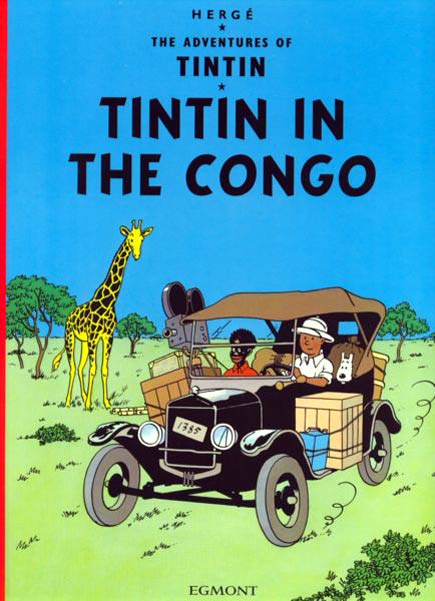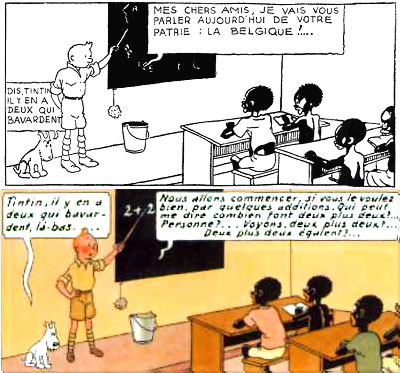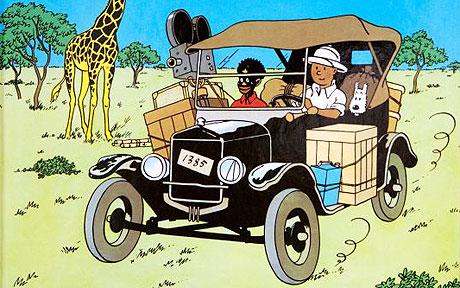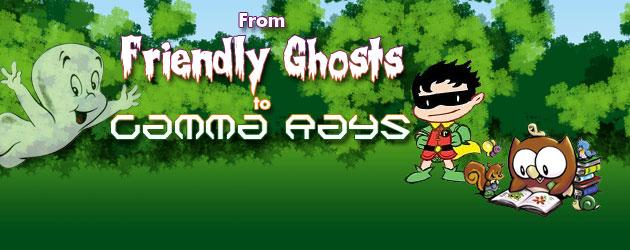
Welcome to another extra edition of From Friendly Ghosts To Gamma Rays! We continue our extra series where we are looking at the entire body of work that made up Herge’s comic The Adventures of Tintin, as we count down the days to the big motion picture comic book adaptation directed by Steven Spielberg and produced by Peter Jackson. Today we look at his second story arc, Tintin In The Congo!
In June of 1930, Le Petit Vingtieme started running Herge’s second Tintin story arc, Tintin au Congo (translated as Tintin in the Congo). Running until July of 1931, over the course of a year readers were delighted by adventures of their favorite reporter and his dog Snowy in what was then Belguim’s colony in Africa, the Congo. At first it seems there is less plot than Tintin’s first adventure in the Soviet Union, starting simply with Tintin taking an assignment to go to the Congo and write articles on his adventures. At first we get a lot of colonial follies – Tintin hunting on safari, mishaps with Snowy – but soon a plot emerges. Halfway through a baddie shows up, and at first with the help of a local Congolese chief, tries to bump Tintin and Snowy off. Turns out the baddie really works for then living real life gangster Al Capone in the U.S., who, wanting to expand his power beyond Chicago, is trying to tap into the diamond mines of the Congo. After the baddies are cleaned up, Tintin does a little more big game hunting and then goes back home to Belgium. Hardcore fans will notice at the start a group saying goodbye to Tintin that includes Quick and Flupke (two trouble makers who were also Herge’s creation in their own self-titled comic strip just starting out on Le Petit Vingtieme at this time) and a boy scout who resembles Totor (Herge’s first comic strip creation). If you have a later colorized/redrawn version of the story, Herge drew in Thomson and Thompson, the twin detectives who wouldn’t actually be introduced until the fourth Tintin story arc, Cigars of the Pharaoh.

So the first thing about this book is that it is notorious for its portrayal of the Congolese people. It was a sign of the times that was reflected in everything from Mickey Mouse strips to the big screen, and author Herge later in life admitted this. Also like the Soviet story arc, Herge contributed all his facts of a travel book or two, so over the years gaps in what turned out to be fact versus fiction have arisen. Lastly, a lot of people are mad over Tintin’s safari. Yes, to save Snowy who was captured by a monkey, Tintin does shoot a monkey, cut him open, and climb inside to wear the pelt as a disguise. Yes, there is a gag where Tintin keeps shooting what he thinks is the same gazelle, and it turns out to be a pile of like twenty of them in the end. Yes, Tintin drills a hole into a rhinoceros, puts a stick of dynamite in him, and blows him to pieces (no joke, I know that last one sounds ridiculous). All of these gags are signs of the time, seen from Jungle Jim to Tarzan, and in later editions of the story after being colorized, Herge would take out certain things, like the pages of the rhino being blown to bits and such.
Tintin in the Congo was first published as a collection in 1931. The style is much like Tintin in the Land of the Soviets, and all the pages are made up of anything from a single splash page to six blocks, mostly ending in cliff hangers or gags of the week. The characters of Tintin and Snowy start to look more refined than how they started out, but still not on the button yet to how we commonly know them. The story would be colorized in 1946 with pages redrawn, entire

sections cut out, and some changes in dialog (an example is a section where Tintin is trying to teach Congolese children about “their” country “Belgium,” is changed to him trying to teach them math). In 1975 it would be republished again with the infamous rhino-meets-explosion scene cut out and replaced with a scene where the rhino gets scared by Tintin’s gun shot and runs off. Finally, in 1991 the book would at last, 60 years later, be published in English, making it the very last Tintin book in the series to make it into English translation. Oddly, the 1991 English version would be the original 1931 black and white version, with original translation and art, and treated as a museum piece reflective of the time it was made in.
Still, although the book has been publicized up and down, that hasn’t stopped people still until this day complaining and trying to remove it from shelves. As recently as 2007 alone, three different cases in the United States, Great Britain, and Herge’s home turf of Belgium, attempts have been made to permanently ban and get rid of the book. The English version of the book has been out of print for some time now in the United States. The French language version is easy to find online, but for the translated version you’ll need to do a little digging to hunt it down (oddly, I got mine from a used text book site that was using it in a college class on Race and Entertainment).
Love it or hate it, Tintin in the Congo is the second story arc in the series. If you go into it with the mindset that it’s a product of that period, there are a ton of hysterical gags. In fact, I enjoyed the book very much for its humor alone (and yes, for those who are curious, I thought the gag of him blowing up a rhino was funny). Is it the thinnest plot out of all the adventures? Yes. Take this one for what it is. We’ll see you soon in Part 3, when Tintin comes to the United States!
For Part One of our Tintin series, click here: In the Land of the Soviets
Drew McCabe
drew@comicattack.net



